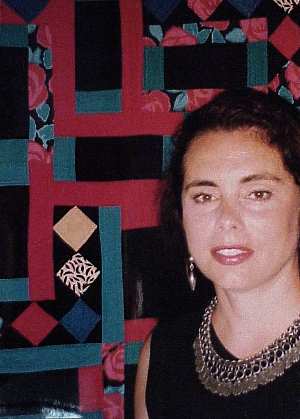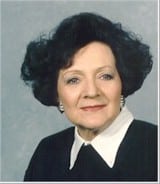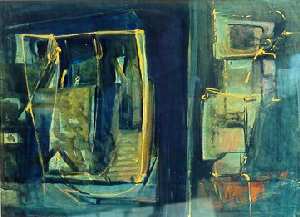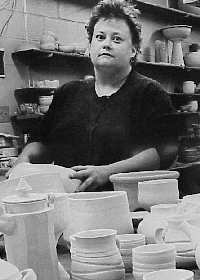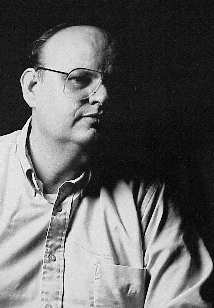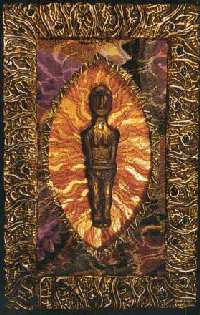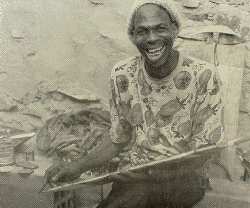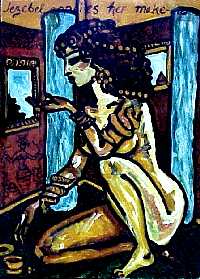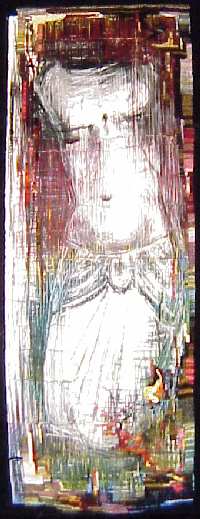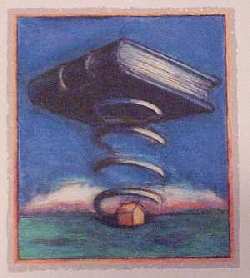FMU Art Alumni Invitational
Hyman Fine Arts Center Galleries
August 31 – October 15, 1999
Interpretations in Fabric by Roberta Olmstead
Smith University Center Gallery
August 31 – September 30, 1999
This collection is largely the fruit of a four-year period spent in Jordan. As an Arab American I went to Jordan twelve years ago hoping to discover something about the roots of my family’s culture; I found a people and a land which have inspired my art work ever since. I loved the kindly warmth of the people, which for me was reflected in the warm and varied tones of the landscape whose patterns I have attempted to capture in my quilts. The richness of the culture and the depth of its history have also been important to me, and there are traces in my work of the 6th century B.C. Nabatean culture of Arabia Petraea in the south, the 8th century A.D. Ommayyad hunting palaces in the northern desert area, the many Greco-Roman ruins, and the modern traditional beduin and peasant arts and crafts in fabric and jewelry.
Water Media Abstractions & Non-Objective Paintings by Rose Metz
Smith University Center Gallery
October 5 – November 5, 1999
“My pictures are all moments of my life … instantaneous visual experiences, often noted spontaneously. When I begin to paint, it’s like leaping into the unknown & never knowing how I’ll get back.”
A resident of South Carolina since 1975, Rose Marie Metz has taught watercolor painting & drawing at the Sumter Gallery of Art for many years. Additionally, she has taught a class in Summerton, SC, & has given workshop instruction in Columbia, Florence, & Lancaster, SC.
Her professional education background includes studying at the Cleveland Institute of Art, the Fort Worth Museum of Western Art, the University of South Carolina and for many years, the Leroy Springs Art Workshops in Myrtle Beach, SC. She has studied abroad at Peterboro, England & the Fortman Studios in Florence, Italy. She has taken numerous painting seminars with such noted artists as Betty Lou Schlemm, Ferdinand Petrie, Alex Powers, Robert Mills, and Guy Lipscomb.
She has shown versatility in her choice of subject matter by painting abstracts,landscapes, florals, still life, figure study & collage. She has received many awards & her paintings reside in collections in the U.S., and abroad in Germany, Switzerland & Italy. In 1991 she was awarded first place in the South Carolina Watercolor Society Competition, Best in Show in the Sumter Fall Fiesta in both 1990 and 1991 & Honorable Mention in the 1991 Beaufort Water Festival Show. Recently she won third place in Mixed Media at the 1992 State Fair & Honorable Mention in the 1992 Springs Travelling Exhibition. She has held one woman shows in Camden, Lancaster & the Florence, SC Museum. Corporate purchases of her works include Riley & Company, Aircap Industries, the Sumter Cultural Commission, the Springs Industries Collection, J.C. Bradford, Siebels Bruce. Commins Moses Realty, Galloway & Moseley, Fort Roofing & Edens Peanuts. She has also been accepted in shows in Oklahoma & Los Angeles, California.
Metz has been accepted by the SC Cultural Commission to participate in the Artist-in-Residence Program & is a member of the SC Watercolor Society & the Sumter Artists Guild.
Useful Pots: Thrown and Altered Works in Clay by Lori Leary
Hyman Fine Arts Center Gallery
October 19 – November 24, 1999
“Mastery of the scientific, technical and observational skills required for the creation of works in clay is an essential element of my work, as is the appreciation of works created in the past. My art is created by combining craftsmanship, knowledge, aesthetic vision, and the often capricious nature of the process and materials, as well as by acknowledging, respecting, and building upon work that has been done by past generations. My intent is to create works that speak for themselves in unique, beautiful, and elegant voices.”
A potter for eleven years, Leary maintains a studio in Murrells Inlet, South Carolina.
A graduate of Georgia State University with a degree in nursing, Leary has studied Ceramic Arts at the Bethune Arts Center and Gibbes Museum Studio in Charleston, South Carolina, The D’Art Center in Norfolk, Virginia, and at the University of California Craft Center, San Diego.
Leary is currently developing and teaching a clay program for adults and children through Georgetown County Parks and Recreation Commission. She has taught in Charleston, San Diego, and most recently at Brookgreen Gardens in Murrells Inlet.
In 1998, Leary co-founded Arts by Fire, an organization for individuals whose interests, talents, or careers are focused on art and fine craft produced with the use of fire. Her work may be found in private collections and in local galleries.
Stephen Nevitt: Reflections on Family and Faith
Hyman Fine Arts Center Gallery
October 19 – November 24, 1999
“Issues of family and faith have been dominant in my work for many years. Choices for this show involve a blend of older and more recent pieces which reflect these themes through use of drawing, printmaking, painting, and mixed media processes. Included are self-portraits, images of relatives, and symbols which relate to religious concerns.
“At the heart of my work is a sincere concern for human experience. I feel that my work reflects facets of my personal life and beliefs as they relate to others through the ages. My role models in this regard are Rembrandt, Durer, Kollwitz, Goya, Van Gogh, and others.
“I would like to dedicate the work for this show to my mother, Lillie Mae Bratcher Nevitt, who passed away in March of 1997.”
Stephen Nevitt has been a member of the Columbia College faculty since 1976. He is currently Professor and Chairman of the Department of Art. He has worked with the summer program of the SC Governor’s School for the Arts and Humanities, 1985 to the present (Assistant Chair of VA Division 1991 & 1992, Co-Chair 1993 to present).
Born in Charlotte, NC and raised in Columbia, SC, he is married to Jane Bishop Nevitt and has two children. He received the BFA in 1971 from the University of South Carolina, and the MA in 1973 from State University of New York, College at Oswego.
Heidi Darr-Hope: Pathway Icons & Necessary Losses
Hyman Fine Arts Center Gallery
January 11 – February 25, 2000
“Early in this decade, I found the contemporary art scene no longer satisfied me as it once had. I was troubled and uneasy with what I perceived as sterile, over intellectualized, lifeless art, produced by artists living within a spiritual wasteland. I longed for healing, for sincere, heart-felt, passionate expressions, not art fulfilling the popular demands of the moment. As I look retrospectively at two postcards I received, one of a Byzantine Icon, the other of a Mexican Retablos painting, I am reminded of the strange and wonderful power of synchronicity. That these images radiated with a powerful presence and were created out of a desire to enable humanity to experience a relationship with the spiritual, set me on a search for the ancient power inherent within an art that was once sacred….
“Just as shamans and healers, the artists of “primitive cultures,” acted as intermediaries to untap and explore areas of the soul, I am now convinced that contemporary artists have the same potential to become the shamans for our culture, to share their visions and stories of personal growth in order to heal themselves and thus contribute to the healing of our world.”
A professional artist with more than 20 years of studio experience, Ms. Darr-Hope is an artist-in-residence at the Center for Cancer Treatment and Research at Richland Memorial Hospital in Columbia, South Carolina. She maintains an active exhibition schedule, showing nationally as well as internationally, and her art work is included in numerous private and corporate collections, such as Coca-Cola USA, HBO, and Bell Communications.
Ms. Darr-Hope received a master of fine arts from the University of South Carolina. Her international studies have taken her to Europe, the Caribbean, and South America, and she has completed postgraduate training in dream analysis, ancient mystical symbology, and art as medicine.
The Painted Koranic Boards of Malam Zabeyrou
Hyman Fine Arts Center Gallery
January 11 – February 25, 2000
Text © Alice Burmeister, Ph.D.
Department of Art and Design
Winthrop University, Rock Hill, SC
African art is often recognized for being both visually striking and spiritually potent. While carved wooden masks and figures are the types of art objects we usually associate with Africa, less known are the works which challenge these Western-imposed notions of what African art can or should be. Such is the case with the painted koranic boards of Malam Zabeyrou, an artist whose work was first exhibited publicly last year at Winthrop University Galleries in Rock Hill, S.C., and has also been featured in Revue Noire, a journal dedicated to contemporary art of Africa. A Muslim clergyman and scholar born in the 1940s in Niger, West Africa, Zabeyrou has become internationally recognized for his work – objects which transcend their more traditional religious function to express deeply held beliefs and lived experience.
While koranic boards are generally used throughout the Muslim world as a kind of writing tablet, on which individuals read and write Arabic verses in ink from the Koran (the holy book of Islam), Zabeyrou chose instead to use brightly colored enamel paint to write both religious and secular phrases in a unique compositional layout in order to draw attention to the messages of his boards. Like the Bible, verses from the Koran are seen by Muslims as the Word of God (or Allah). Indeed, for Muslims the Word is God, and these boards (and the act of writing on them) are seen as sacred works. Thus by using the koranic board format, and referencing the religious authority of Islam via holy verses in Arabic, Zabeyrou was deliberately tapping into the spiritual vitality of this rich and historic tradition.
This strategy draws attention to the subject of his boards, a combination of Arabic, English, and French words which make reference to his unjust imprisonment for selling Muslim literature in 1985. Because this event occurred on the eve of the arrival of George Bush (then Vice President on official visit to Niger), Bush’s name, along with other key words and phrases which evoke this event, frequently make an appearance on these boards. Zabeyrou thus used these words, within an already established religious framework, to create an ongoing discourse – a discourse which he hoped would communicate the truth behind this injustice, and thereby elevate God’s name. In the end, these works ultimately testify to the power inherent in such objects, and to the ways in which an artist can transform common items into works of art which are truly dynamic, both visually and conceptually.
The boards in this exhibition were collected over a ten-year period by Dr. Alice Burmeister, Assistant Professor in the Department of Art and Design at Winthrop University, who first met Zabeyrou in 1989 while serving as a Peace Corps Volunteer in the Maradi region of Niger. Four return trips by Burmeister during her subsequent doctoral research in the art of that region resulted in a lasting friendship with the artist who consistently and graciously shared his life history and the ongoing process of his work with her. The photographs accompanying the exhibition were taken during Burmeister’s field research in 1996 and ’98, and reveal both the artist at work, as well as the environment that he created for himself: a cluster of cement buildings located at the intersection of four major streets, which he painted with the same styled messages as those found on his boards. Zabeyrou’s unexpected death in December of 1998, virtually on the eve of his first public exhibition at Winthrop University, lends poignancy to the life of a talented man who never ceased to communicate both the beauty of Islam and his personal imperative for social justice throughout the most artful of means.
Messages: Sculpture by Jean Grosser
Hyman Fine Arts Center Gallery
February 29-March 31, 2000
“As an artist, I am interested in using visual expression to explore issues of social and political conflict. These interests stem from a family tradition of political activism. My grandfather was a conscientious objector during World War I. His experiences in military prisons (Alcatraz and Leavenworth) between 1918 and 1921 have been the subject of my artwork in the past.
“Since 1990, I have been a member of the human rights group Amnesty International. I participate in their letter writing campaigns on behalf of political prisoners, generally sending between 12-16 letters each month. My current artistic focus developed out of a need to do more than write letters. I began creating sculptures inspired by the plight of political prisoners, constructing duplicates of each art work so I could mail one to the offending government and exhibit the other.
“While I continue to create artworks that focus on social conflict and prisoners of conscience, I do not limit myself to individuals identified by Amnesty International. In “Southern Gentlemen” I explore the cultural conflicts stemming from the legacy of slavery and the Civil War, which are still very much alive in the American South.”
Jean Grosser is Professor of Art and Chair of the Art Department at Coker College in Hartsville, South Carolina.
The Glamour of the Dark Myth:
Short Dictionary of Misunderstood Women
Paintings by Susannah Sigaloff
Hyman Fine Arts Center Gallery
February 29-March 31, 2000
“I wanted to approach a more deliberate and conscious existence, but found voluptuous shadows in my soul’s recesses. As product of two cultures, born in Russia and raised in America from the age of 10, my ideas about the role of women in society were founded in mu Russian childhood and American media. Like many other foreigners, I was confused about the difference between the culture of America and its popular culture. To live deliberately and gracefully as an ambitious woman in American society, I had to discover the shape of my conviction and to re-appraise my illusions and expectations. I found it easier to paint my fears and preconceptions. The questions that fueled the re-discovery of my native culture and that of my new homeland were: how to maintain and nurture a sense of self and soul despite my need for approach and acceptance from my peers, parents, employers, educators and critics; and out of what archetypes does our culture build its heroines and, more importantly to me, its villains? In the end, it was the anti-heroines that I wanted to study. I wanted to examine the influences of these possibly mythical women. Their beautiful, brutal lives served as both cautionary tales and siren songs to a shadowy vertigo. They are celebrated in lore and song, even as their humanity is converted to fiction.
“Several artists were extremely influential to this series, in particular those that worked in the period between the two world wars. The German Expressionist school of painting, with its credo of emotional, brutal honesty, broad strong strokes, and unflinching vision has been a guide in my development as an artist. I especially admire the work of two artists; Max Beckman with his intense, immediate colors and mythological allegories; and Oscar Kokoschka, who used urgent, insistent lines in his graphics ad paintings. The heroic sweep of America muralist and painter Thomas Hart Benton’s figures and his sense of myth making and portraiture are very important to me. In addition, I studied the covers of 30’s and 40’s pulp novels and film noir advertising posters and their sanguinary, dramatic depiction of women.”
Triennial ‘98 artist Susannah Sigaloff was born in Kiev, Ukraine in December of 1971. Her family later immigrated to the United States after a brief stay in Italy and Austria, and after several moves from state to state, ended up in South Carolina during Susannah’s high school years.
In her sophomore year she attended the S. C. Governor’s School for the Arts, and then The Fine Arts Center in Greenville, S. C. She recently graduated from Clemson University with a degree in Civil Engineering.
Woven Drawings by Kit Loney
Smith University Center Gallery
February 29-March 31, 2000
“For the drawings I choose, as subjects, statues from past eras: ancient Greece and Egypt, Romanesque. The images are battered (by time, by circumstance), often missing an arm, legs or head. I am interested in how these fragments still evoke the sensitivity and depth of human identity. I try to let this life of the pieces enter the drawings through touch and through mark.
“I fragment these identities further. I tear apart the paper they are drawn on. The paper becomes here no longer simply a surface to hold an illusion, but a tangible, physical structure with particular character, particular thickness and weight. During the weaving process the paper scraps share the function of the weft yarns-so much matter to weave into the warp threads to create a fabric.
“I have become interested in the rhythmic repetition that constitutes so much of the weaving process. The layers of activity that physically build the piece have about them a meditative function as well. There is an engaged repetition in the tying of, say, seventy or eighty knots, the winding of several hundred threads, or the steady passing back and forth of a weft yam through the warp strings. In these particular works this weaving process is what brings about the partial reconstruction of the drawn images-partial, in that the evidence of their fragmentation and resurrection becomes a characteristic of their new identity.
“I have followed my work to this place, to this edge of definition: The images arise through the drawing activity, yet, once torn, would be just so many scraps of paper without the engagement of the weaving process. They make an odd sort of fabric.”
Kit Loney received her B.F.A. from the University of Massachusetts in 1978, studied at the Penland School of Crafts (Penland, N.C.) in 1984 and received her M.F.A. from the University of South Carolina in 1991. She has been teaching art at Fort Johnson Middle School in Charleston since 1997 and has extensive teaching experience, including artist residencies, in Charleston, Greenville, Sumter, Horry and Darlington counties and in Lewiston, N.Y.
Loney most recently was the subject of a one-person exhibit, entitled Woven Drawings, at the Spartanburg Museum of Art. She has exhibited in museums, galleries and crafts shows throughout South Carolina, the United States and in Iceland. Her work has been featured in various publications.
Richard Rose: “The Metaphorical House,” Traditional and Digital Prints
Hyman Fine Arts Center Gallery
April 4 – May 6, 2000
“What is a house?” … is the central question posed by this work. Perhaps more than any other kind of constructed form, the house carried many layers of meaning: utilitarian, domestic, cultural. There is, however, something else: the house is a metaphor for human experience. This project began with symbolic images and evolved, combining literary texts in the present version as an artist’s book, utilizing both traditional and digital media as giclee prints. The images were not conceived as literal illustrations, but rather as an interpretation of theme. As in poetry and life, I am intrigued by transformation: of words, of images, of self.
Richard Rose studied at the North Carolina School of the Arts, Pratt Institute, Virginia Commonwealth University (B.F.A.) and the University of California, Berkeley (M.A.). Selected exhibitions and publications include: South Carolina State Museum, Muscarelle Museum of Art, the Arts Festival of Atlanta, Southeastern Museums Conference, Design Issues and Studio International. Rose received the Individual Artist’s Fellowship from the South Carolina Arts Commission in 1991. He currently serves as head of the Studio Art Division of the University of South Carolina Department of Art.
